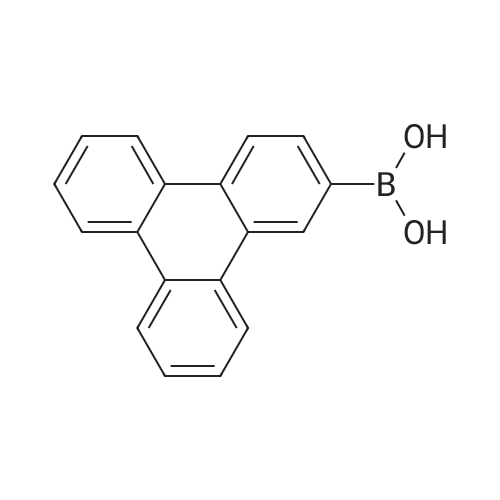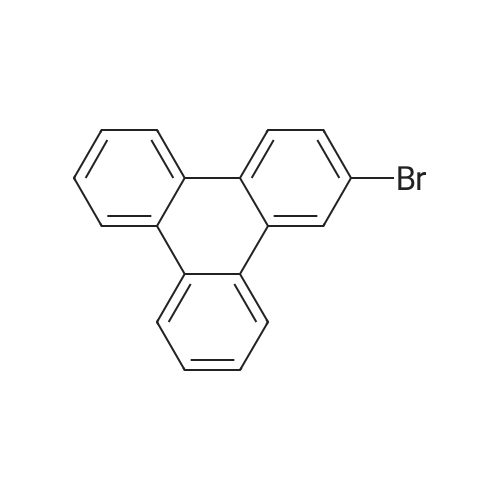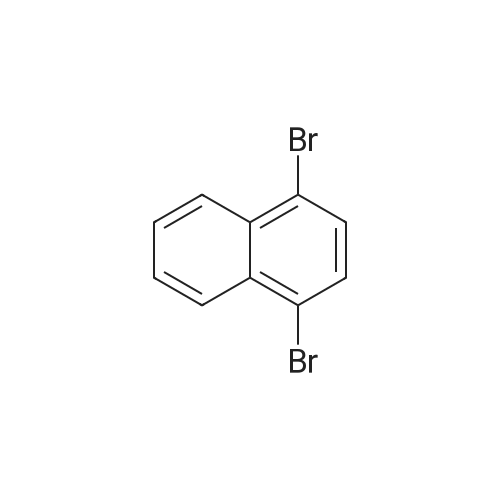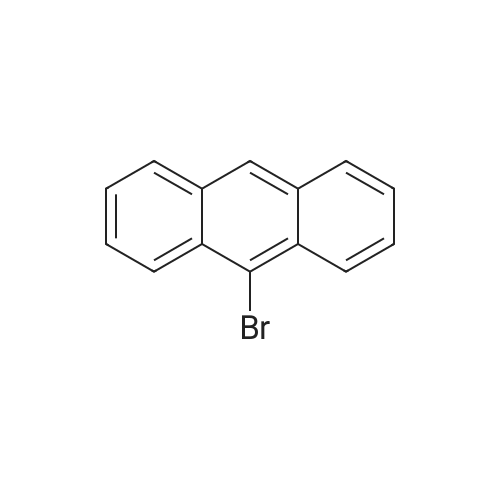| 90% |
With potassium carbonate;palladium diacetate; tris-(o-tolyl)phosphine; In ethanol; water; toluene; at 80℃; for 3h;Inert atmosphere; |
Example 5In this example, an example in which 9-phenyl-3-[3-(triphenylen-2-yl)-phenyl]-9H-carbazole (abbreviation: mPCzPTp) represented by Structural Formula (111) in Embodiment 1 is manufactured will be described. In a 50-mL three-neck flask, a mixture of 0.7 g (1.8 mmol) of 3-bromo-9-phenyl-9H-carbazole, 0.5 g (1.8 mmol) of triphenylene-2-boronic acid, 4.1 mg (18 mumol) of palladium(II) acetate, 28 mg (92 mumol) of tri(o-tolyl)phosphine, 6.9 mL of toluene, 2.3 mL of ethanol, and 1.9 mL of a potassium carbonate aqueous solution (2 mol/L) was deaerated while being stirred under reduced pressure, and then heated and stirred in a nitrogen atmosphere at 80 C. for 3 hours to be reacted.After the reaction, an aqueous layer of the obtained suspension was extracted with toluene. The obtained extracted solution and the suspension were washed together with saturated saline, and then magnesium sulfate was added to the obtained solution so that moisture was adsorbed. The suspension was separated by gravity filtration, and the filtrate was concentrated to give an oily substance. This oily substance was purified by silica gel column chromatography. The column chromatography was performed first using a mixed solvent of toluene and hexane (toluene:hexane=1:9) as a developing solvent, and then using a mixed solvent of toluene and hexane (toluene:hexane=1:6) as a developing solvent. The obtained fractions were concentrated to give an oily substance. Toluene and hexane were added to the oily substance, and the mixture was crystallized to give 0.9 g of a white solid that was an objective substance in a yield of 90%. The reaction scheme of the synthesis method is shown in (F5-1). The obtained compound was examined by a nuclear magnetic resonance (NMR) method. The measurement data are shown below.1H NMR (CDCl3, 300 MHz): delta (ppm)=7.30-7.54 (m, 5H), 7.60-7.80 (m, 12H), 8.01 (dd, J=8.4 Hz, 1.5 Hz, 1H), 8.14 (s, 1H), 8.23 (d, J=7.8 Hz, 1H), 8.47 (d, J=2.1 Hz, 1H), 8.67-8.80 (m, 5H), 8.95 (d, J=1.5 Hz, 1H).FIGS. 20A and 20B are 1H NMR charts. Note that FIG. 20B is a chart showing an enlarged part of FIG. 20A in the range of 7.0 ppm to 9.0 ppm. The measurement results confirmed that mPCzPTp that was the objective substance was able to be obtained.FIG. 21A shows an absorption spectrum of mPCzPTp in a toluene solution of mPCzPTp, and FIG. 21B shows an emission spectrum thereof. FIG. 22A shows an absorption spectrum of a thin film of mPCzPTp, and FIG. 22B shows an emission spectrum thereof. The absorption spectrum was measured with a UV-visible spectrophotometer (V550, produced by JASCO Corporation). The emission spectrum was measured with a fluorescence spectrophotometer (FS920, produced by Hamamatsu Photonics Corporation). The measurements were performed with samples prepared in such a manner that the solution was put in a quartz cell while the thin film was obtained by evaporation onto a quartz substrate. FIG. 21A show the absorption spectrum of mPCzPTp in the solution of mPCzPTp which was obtained by subtracting the absorption spectra of the quartz cell and toluene put therein, and FIG. 22A shows the absorption spectrum of the thin film which was obtained by subtracting the absorption spectrum of the quartz substrate. In FIGS. 21A and 21B and FIGS. 22A and 22B, the horizontal axis represents wavelength (nm) and the vertical axis represents intensity (arbitrary unit). In the case of the toluene solution, the absorption peak was observed at around 290 nm, and the maximum emission wavelength was 381 nm (excitation wavelength: 290 nm). In the case of the thin film, the absorption peak was observed at around 277 nm, and the maximum emission wavelength was 397 nm (excitation wavelength: 306 nm).The absorption spectrum showed that mPCzPTp described in this example is a material having weak absorption of light in the visible region. In addition, the emission spectrum shows that mPCzPTp exhibits blue-violet emission. |

 Chemistry
Chemistry
 Pharmaceutical Intermediates
Pharmaceutical Intermediates
 Inhibitors/Agonists
Inhibitors/Agonists
 Material Science
Material Science















 For Research Only
For Research Only
 120K+ Compounds
120K+ Compounds
 Competitive Price
Competitive Price
 1-2 Day Shipping
1-2 Day Shipping















